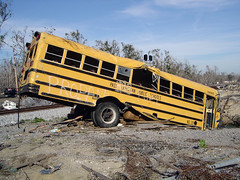
TEN STAFF FOR THIRTY THOUSAND STUDENTS IN NEW ORLEANS
The New York Times recently opined that there is "optimism in many corners" of New Orleans on educational reform in the city. I'm not sure what corners they've been hanging out at, but they are not in poor black neighborhoods.
The Recovery School District (RSD) is the unit within the Louisiana State
Department of Education charged with running the 107 New Orleans schools
that were placed in receivership last fall. The RSD estimates that they
will have 30,000 students in the district by January 2007, most of these
returning displaced students from the poorest black neighborhoods in the
city. A few weeks ago the first signs appeared that something was amiss:
the RSD postponed school openings and admitted that they had not hired a
single teacher for the district. By the time the RSD began vetting
applicants last week, the charter schools and suburban districts had long
since hired most of the available teachers. When I heard that recent
meetings of the RSD staff were virtually all white, I contacted several
members of the RSD staff and could not get a response to my questions about
the current staffing levels and diversity. Last week I finally received an
email from Katherine Whitney, the RSD Chief of Staff (below) who told me
that the RSD had only ten people on staff: ten people running a school
system of 30,000 students! Of the ten staff members, I can only identify
one person responsible for special education programs in which approximately
6,000 special needs students will have to be placed individually--by school
opening day, September 7th. Now the RSD is talking about staffing the
schools with substitute teachers--who were virtually impossible to recruit
before Katrina.
How can the RSD justify this inexcusable lack of planning for the needs of
poor African American students? No matter what occurs in the next few
weeks, there is reason to question what, if any, thought and planning has
gone into the curriculum and instructional resources for the schools. Had
these been 30,000 middle class white children, is there any doubt that the
media--including the New York Times--and business and civic leaders would be howling in protest and demanding that drastic corrective measures be taken immediately?
What cause is this for optimism?
Lance
Lance Hill, Ph.D.
Executive Director
Southern Institute for Education and Research
Tulane University
No comments:
Post a Comment